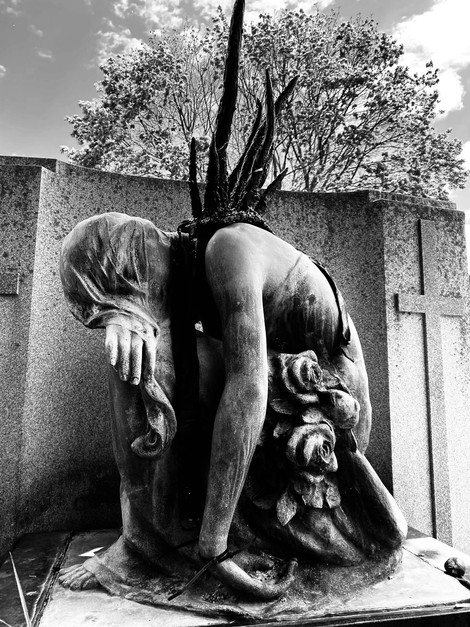Resonance of Solitude: Giovanni Caci's Ostracism-Inspired Collection
- Milan Tanedjikov

- Nov 7, 2023
- 5 min read
Design Process Interview: Exploring the Creative Journey of Giovanni Caci. Conducted by Danielle Medland and edited by Roxanne Ouellet-Bernier, this in-depth conversation is part of a series produced within the framework of a LIGNES DE FUITE short course titled "How to Interview Fashion Creatives and Frame Their Research and Ideas." The course aimed to unite aspiring writers with fashion students, providing them with a unique opportunity to learn the fundamentals of journalism.

Giovanni Caci’s process begins in the dark: lights off, curtains drawn, and in near silence, he describes a state of meditation that can be found in the absence of light. By reducing external stimuli, one can connect to themselves deeply through forced introversion, and this is something deeply integrated into his design process. Giovanni’s research is born here, where in darkness, he brainstorms, working through ideas and concepts either new or old to him.

Coming from an academic background, Giovanni is interested in literature and political science, which act as a framework for the concepts he explores through fashion. Through this lens, he is able to bring a rich design philosophy to his work. His values of freedom and individuality are deeply integrated into the topics he researches, and there is a profound thematic consistency throughout his portfolio. Self-reflection and strength of mind are two crucial elements of his ethos and these ideas are equally present in the work of those who inspire him.
Giovanni mentions two idols, who are vastly different at first glance, but share many of the same moral principles: political critic Christopher Hitchens, and musician Sven Erik Kristiansen, better known as Maniac of the Black Metal group Mayhem. These two individuals are quite different in mystique, but they both display a highly critical outlook on the world in which they live, while also maintaining impressive strength of character – two features essential to the themes he creates through his design work. While Hitchens’ writings inspire his conceptualization of the idea, Kristiansen acts as a literal muse for the designs, both in his appearance and talents as a performer.
Collecting information, through both thought and imagery, is the next step in his design research. From this, Giovanni builds categories of data based on elements such as physical location, emotion, symbolism, muse, and material. The organization of this data is integral to this beginning stage, as it allows him to draw parallels between concepts that start off as very separate. From here, he develops a central method, which acts as the essence of his concept.
During his final year as a student at LaSalle College, Giovanni entered the Arts of Fashion students
design competition. Given the word “Resonance” as a theme, his inspiration for the collection was this aforementioned state of silence and darkness, which he describes as his ideal habitat. He connects this desire for quiet and solitude to the concept of social ostracism, inspired by his own encounters with it. “It shaped me into a stronger, more confident person. You accept this independent position and reject others that can potentially be harmful or subversive to you and your ideas. It’s not about fearing ostracism, but embracing this introversion.” he explains. Deeply intertwined with his personal experience, this theme brings forward a rare emotion, which he describes as
“a dichotomy between pain and pleasure: specifically, selfinflicted pain and the ecstasy that is driven from it.”
These notions of ostracism, solitude, and voluntary discomfort are central to the collection’s ambiance, which is conveyed through shades of black, sharp lines, and religious symbolism. His style is minimalistic and clean-cut while referencing gothic subculture and often, opulent fashions of the past. While this combination of aesthetic elements seems paradoxical, the finesse with which he designs creates harmony between these contrasting inspirations. Giovanni’s ability to infuse his work with such dissonance creates a result that is unique to his personhood, as he explains with his design intentions
“The core element is to repel, to build your own confidence, to scare people. Because we’re living in a state in which a person’s opinion can be disregarded, rejected, and frowned upon. This can exclude them from social interaction because there’s this group-think mindset. The point of this collection is to say, ‘screw them’, to embrace your own ideas, to embrace your own will to power, and embrace the empowerment of yourself as an individual.”

Once this concept was established, Giovanni began his secondary research, which consisted of a history of craft. Inspired by Catholic imagery, specifically the 11th-century Tristan Quilt, trapunto quilting became a point of inspiration. This fabric manipulation, invented in Sicily nearly a millennium ago, consists of quilting through stuffing: first, two layers of fabric are embroidered to form a pattern or image, and are then slashed, filled with cotton, and finally, resewn and assembled into a garment. Giovanni, who is himself Sicilian, took an interest in trapunto because of its rich history and timeless visual effect. In his graduate collection, titled ANATHEMA, an entire coat is decorated using this challenging technique, which through repetitive testing, he has become quite proficient at. The coat depicts imagery similar to that of a stained glass window that could be seen in a church, with characters and symbols that connect to this theme of ostracism. Because of its detailed nature, trapunto is a highly time-consuming manipulation, and he estimates that the realization of this coat could take him anywhere from two to three months, for a total of likely over one thousand hours. Giovanni connects his patience for this sort of detailed work to his affinity for quiet, and mentions that his state of mind when quilting is similar to the one he finds himself in during brainstorming sessions.
This passion for craftsmanship has been integral to Giovanni’s experience as a fashion student, during his time at LaSalle College, he has taken the initiative to learn as much about techniques and manipulations as possible. Over the course of his graduate year, he has worked with a variety of unconventional materials, including silicone, metal, and soundproofing fabric. This testing has allowed him to build a library of experience with various elements of craft, which is something he’s integrated not only into his portfolio but also into his graduate collection, where he displays this knowledge through the use of trapunto and metalwork. Giovanni describes his relationship with textiles as follows:
“Design comes first, color is predetermined, as I design almost exclusively in black, and the fabric comes from the techniques I research. Materials are heavily embedded in the research, as they are all true to their historical backgrounds.”
Linen, cotton, wool, and leather are some of his textiles of choice, which he explains as a design option: while subversion and alternative culture are core elements to his aesthetic, he tries to maintain an air of Italian sensibility through classic silhouettes and tailoring.
Credits
Text Dainelle Medland Images Gio Caci and Connory Ballantyne
We kindly invite you to purchase our products and RSVP to our events. By doing so, you contribute to our thriving community and enable us to create even more amazing learning experiences for fashion creatives. Your continued patronage is deeply appreciated, and we thank you for being a part of our journey.
Originally published in LIGNES DE FUITE vol.3











































